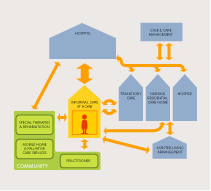The INTERLINKS Framework for Long-term Care
The INTERLINKS Framework for Long-term Care is a set of tools and practice examples to guide the future development of long-term care systems in Europe. Our approach places users needing integrated long-term care at the interfaces between social and health care, and formal and informal care.
Older people and their informal carers are at the centre of our Framework. We began by showing the different pathways that an older person, ‘Ms LongTermCare’, might access in 13 countries across Europe. This highlighted the gaps in care, which we broke down into themes, sub-themes and key-issues. We then collected and analysed examples of good practice to illustrate these key-issues. This is how INTERLINKS demonstrates different approaches and solutions to gaps in long-term care from across Europe.
To build the Framework, we have gathered a large number of key-issues and related practice examples from 13 countries in Europe. These key-issues are focusing on:
- bringing together formal and informal contributions to care;
- linking professional approaches from health and social care; and
- showing older people and their carers their options for long-term care.
Practice examples represent different types of care at many levels, but each of them has been implemented at least once and in at least one place. Our introductory video shows how all the different types of care for older people need to be identified, co-ordinated and managed to improve person-centred care.
The Framework is centred on the older person in need of care and his/her carer, and based on principles that apply to frail and dependent people. These imply that:
- self-direction is important for quality of life;
- the needs of frail older people using long-term care are multiple and should be addressed in their social, physical and societal context; and
- care provision and support should:
- empower clients;
- strengthen their self-direction; and
- support them to live a valuable and dignified life.
To construct integrated long-term care systems we need cohesion, continuity of service delivery and staff support. These are our key values.

Framework themes
1 Identity of Long Term Care
What is long-term care? We want to define it in a way that everyone understands. Some countries are developing formal policies and definitions for LTC, while informal everyday care is evident in all countries. Every society needs basic values and rationales to understand political and societal choices in LTC and how LTC is carried out in everyday practice.
To improve LTC in Europe, we need to find and highlight any systematic approaches that define LTC as a single entity – or at least as a specific area of social risk.
Elements in this theme include:
At systems level
- national governments’ key papers;
- legal guidelines and principles; and
- the regulation of migrant caregivers.
At organisational level
- mission statements addressing links and interfaces;
- civil society initiatives; and
- educational aims.
2 Policy and Governance
How do policy and governance in LTC deal with links and interfaces – at both organisational and systems levels?
- By policy we mean implementation directives; while
- in governance we look at the links between government at different administrative levels and other stakeholders involved in decision-making, performance and control.
Elements in this theme include:
- examples within policy papers;
- reform proposals;
- task force or working group reports for ministries or governments;
- legal texts (preambles);
- statements by interest organisations or other political stakeholders;
- programmes, guidelines and strategies; and
- analyses and results of comparative research.
3 Pathways and Processes
How do older people and informal carers enter and leave care processes? This theme gives examples of the processes that need to be in place to address needs. Pathways and processes go hand-in-hand:
- A pathway refers, in a longitudinal way, to the diversity of settings the older person and informal carer will encounter from the moment they enter LTC to the time they leave it.
- A process is any professional activity that takes place in and at the interface of the organisations involved, or at the service delivery level.
4 Management and Leadership
How can we develop, manage and lead long-term care? A comprehensive and integrated LTC system requires sophisticated and innovative approaches to management and leadership.
Elements in this theme include:
- organisational development;
- human resource management;
- inter-organisational relations;
- quality development;
- bringing together the perspectives of older people and informal carers; and
- integrating prevention and rehabilitation approaches.
5 Organisational Structures
How do we best organise long-term care? Different organisational structures provide LTC services at various stages along individual care pathways. Often two or more services (such as home help, acute medical treatment and rehabilitation), provided by different organisations and often in different settings, have to be available at the same time.
In all settings, seamless LTC pathways and processes require organisational structures that:
- link and co-ordinate approaches between organisations;
- foster interprofessional co-operation; and
- match specialised services with comprehensive personal needs of older people and informal carers at the same time.
Each sub-theme in this theme represents a LTC setting or facility. We provide a list of possible approaches for each sub-theme to show how they are organised to promote seamless care.
6 Means and Resources
How is long-term care funded and resourced? LTC expenditures are set to rise over the coming years, so we need to use resources as effectively and efficiently as we can. Designing shared funding mechanisms and allocating financial, human and technical resources will be key issues to guarantee support for people with LTC needs.
Elements in this theme include:
- funding and budgeting;
- human resources;
- information technology; and
- other technical support.
- Login to post comments


